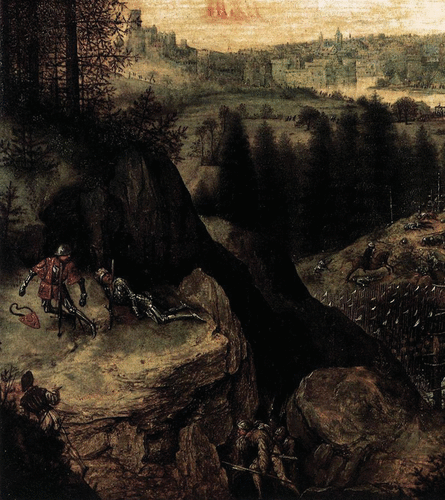The Suicide of Saul by Pieter Bruegel the Elder

The Suicide of Saul by Flemish Renaissance artist Pieter Bruegel the Elder (c. 1525–1569) depicts the self-murder of Jewish King Saul after defeat by the Philistines, as described in the Bible: “Now the Philistines fought against Israel; […] And the Philistines killed Jonathan, Abinadab, and Malchishua, Saul's sons. […] Then Saul said to his armorbearer, ‘Draw your sword, and thrust me through with it, lest these uncircumcised men come and thrust me through and abuse me.’ But his armorbearer would not, for he was greatly afraid. Therefore, Saul took a sword and fell on it. And when his armorbearer saw that Saul was dead, he also fell on his sword, and died with him” (1 Sam. 31, 1–5). Saul probably suffered from an affective disorder, most likely depression, which may have played a significant role in his suicide. In the Bible, this condition is described as the possession of an evil spirit who came upon Saul from God (1 Sam. 16:23). According to Stein (1), a bipolar disorder, with sudden states of excitement and “prophetic frenzy,” may actually be responsible for Saul’s condition. Bruegel often depicted psychiatric conditions in his works, such as Cutting Out the Stone of Madness (1550), Dulle Griet (Mad Meg) (c. 1562), and his drawings on dancing mania, deeply analyzed by Jean Martin Charcot (2). In The Suicide of Saul, Bruegel chose to represent the highly dramatic moment of the death of Saul and his armor-bearer, as the Philistines are taking over. As with most of his biblical subjects, the painter shows the armies in 16th-century armor, treating Saul's suicide as a contemporary event. Saul, who can be seen already dead and almost relegated to the left margin, does not occupy the center of the stage. Rather, the center shows the countless Philistines who took control of the battlefield. The loneliness and marginalization of the figure of the King of the Israelites and the darkness and gloominess of the entire painting provide an atmosphere of sadness and melancholy that well represented the depressed mood of Saul, who decided to take his own life.
1 : The case of King Saul: did he have recurrent unipolar depression or bipolar affective disorder? Br J Psychiatry 2011; 198:212Crossref, Google Scholar
2 : Neurological implications and neuropsychological considerations on folk music and dance. Prog Brain Res 2015; 217:187–205Crossref, Medline, Google Scholar



